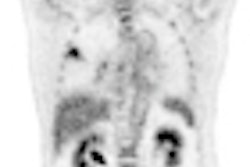Philadelphia researchers have found that it's possible to reduce PET radiotracer dose among pediatric patients and still maintain image quality, according to a new study in the February issue of the Journal of Nuclear Medicine.
Researchers from Children's Hospital of Philadelphia (CHOP) and the University of Pennsylvania concluded that pediatric PET of "constant image quality can be performed with time or dose savings up to 50% for the lightest pediatric patients" in the range of 20 to 45 lb (J Nucl Med, February 2010, Vol. 51:2, pp. 293-300).
The significance of the study is that PET can be used in children with more specific standards than guidelines currently in place for administering radiopharmaceutical doses to adults, according to lead author Roberto Accorsi, Ph.D., former research assistant professor of radiology at CHOP and the University of Pennsylvania.
Injection protocol
The group used CHOP's recently installed PET/CT scanner (Gemini 16, Philips Healthcare, Andover, MA) for pediatric imaging for the study. For a one-hour uptake period, the manufacturer-suggested injection protocol for the PET/CT system is 5.18 MBq/kg (0.14 mCi/kg), with a minimum dose of 74 MBq (2 mCi) and a maximum dose of 444 MBq (12 mCi). The injection protocol, the study noted, is consistent with the recommended dose regimens for adults.
A whole-body PET scanning protocol at CHOP has two components: scanning from midthigh to the base of the neck, with arms above the head, followed by a scan from the base of the neck to the eyes, with arms alongside the body. Only the first part of the scan was considered in the study.
The researchers retrospectively reviewed 73 patients, whose weight ranged from 25 to 200 lb, and collected data to perform calculations based on patient-specific noise-equivalent count rate (NECR) and noise-equivalent count rate density (NECRD), which include information on minimum dose and minimum time to achieve constant image quality.
Retrospective estimate
"It was possible to estimate retrospectively for each patient the scan time that would have been sufficient for the same NECRD as in a 70-kg [150-lb] reference adult; the reduced dose sufficient for constant NECRD and scan time; and a general relationship among scan time, dose, and NECRD," the authors wrote.
Following clinical injection guidelines based on a proportion of a patient's weight, NECRD increased as weight decreased. "This advantage could be traded in whole or part for reduced scan time or injected dose," they concluded. "As compared with height, girth, and [body mass index (BMI)], weight was found to be the patient statistic correlating best with the dose necessary for imaging at constant [noise-equivalent count density curve (NECD)] and time."
By Wayne Forrest
AuntMinnie.com staff writer
February 1, 2010
Related Reading
Pediatric low-dose PET/CT protocols cut radiation dose in half, October 1, 2009
Dose can be reduced by 75% in pediatric chest CT exams, June 18, 2009
Color coded CT protocols help reduce pediatric radiation dose, June 4, 2009
SPR group tackles radiation dose in pediatric nuclear medicine, May 22, 2009
SPR news: Rads must take lead in reducing pediatric CT dose, April 23, 2009
Copyright © 2010 AuntMinnie.com



















